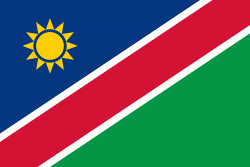Oranjemund
Oranjemund (German for "Mouth of Orange") is a diamond mining town of 4,000 inhabitants situated in the ǁKaras Region of the extreme southwest of Namibia, on the northern bank of the Orange River mouth at the border to South Africa.
The entire area along the shore of the Atlantic Ocean was proclaimed restricted (the Sperrgebiet) in 1908 due to the occurrence of alluvial diamonds. Since then the public was forbidden to enter it. In 1927 diamonds were found south of the Orange River in South Africa. Hans Merensky and other prospectors assumed that the northern shore on South West African territory would also have diamonds. A year later they conducted an expedition from Lüderitz 300 km to the mouth of the Orange. They found rich deposits on the north bank of the Orange River and the adjacent northern coastline and established a tent camp from which Oranjemund developed.
Due to the Great Depression, diamond mining was not taken up until 1935, and a year later workers' houses were erected. Oranjemund as a formal settlement was thus established in 1936. Production of mainly gem-quality diamonds has remained in the region of 2 million carats (400 kg) per year since inception of the mine, mainly through improvements in technology.
Until 2017 the town was run by Namdeb (formerly Consolidated Diamond Mines), now a subsidiary of De Beers. Access to, and settlement in Oranjemund was restricted to employees and their relatives. Its infrastructure is superior to that of other towns in Namibia's South, due to it not being dependent on cost recovery from its inhabitants. In the second half of the 20th century, Oranjemund featured a large recreational complex with swimming pool, cinema, restaurants and bars. Water is still provided free of charge, and until 2016 so was electricity.
Oranjemund was proclaimed a town in 2011.
The entire area along the shore of the Atlantic Ocean was proclaimed restricted (the Sperrgebiet) in 1908 due to the occurrence of alluvial diamonds. Since then the public was forbidden to enter it. In 1927 diamonds were found south of the Orange River in South Africa. Hans Merensky and other prospectors assumed that the northern shore on South West African territory would also have diamonds. A year later they conducted an expedition from Lüderitz 300 km to the mouth of the Orange. They found rich deposits on the north bank of the Orange River and the adjacent northern coastline and established a tent camp from which Oranjemund developed.
Due to the Great Depression, diamond mining was not taken up until 1935, and a year later workers' houses were erected. Oranjemund as a formal settlement was thus established in 1936. Production of mainly gem-quality diamonds has remained in the region of 2 million carats (400 kg) per year since inception of the mine, mainly through improvements in technology.
Until 2017 the town was run by Namdeb (formerly Consolidated Diamond Mines), now a subsidiary of De Beers. Access to, and settlement in Oranjemund was restricted to employees and their relatives. Its infrastructure is superior to that of other towns in Namibia's South, due to it not being dependent on cost recovery from its inhabitants. In the second half of the 20th century, Oranjemund featured a large recreational complex with swimming pool, cinema, restaurants and bars. Water is still provided free of charge, and until 2016 so was electricity.
Oranjemund was proclaimed a town in 2011.
Map - Oranjemund
Map
Country - Namibia
 |
 |
| Flag of Namibia | |
The driest country in sub-Saharan Africa, Namibia has been inhabited since pre-historic times by the San, Damara and Nama people. Around the 14th century, immigrating Bantu peoples arrived as part of the Bantu expansion. Since then, the Bantu groups, the largest being the Ovambo, have dominated the population of the country; since the late 19th century, they have constituted a majority. Today Namibia is one of the least densely populated countries in the world.
Currency / Language
| ISO | Currency | Symbol | Significant figures |
|---|---|---|---|
| NAD | Namibian dollar | $ | 2 |
| ZAR | South African rand | Rs | 2 |
| ISO | Language |
|---|---|
| AF | Afrikaans language |
| EN | English language |
| DE | German language |
| HZ | Herero language |















